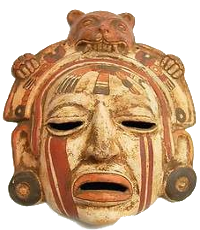Kingdoms of Peru
Everybody has heard of the Incas but next to no one has heard of the many diverse societies that preceded them. Yet there were many cultures, kingdoms and empires in the highlands of the Andes, on the narrow coastal plain of the Pacific Ocean and in the Amazonian jungle. These are a few examples:
The Nazca culture, 100 BCE – 800 CE, flourished in the river valleys of southern Peru. They produced complex textiles and ceramics and are famous for their geophyphs, line-drawing of animals and humans which are best viewed from the sky.
The Tiwanaku empire, 300-1150 CE, was located on the shores of the lake Titicaca. Tiwanaku was a city which at the height of its power may have had some 100,000 inhabitants. The Tiwanakus kept llamas, caught fish in lake Titicaca and used its water to irrigate their fields. They traded widely across their empire which gave them access to a varied diet.
The Muisca Confederation, 1450-1550 CE, was a loose alliance of rulers in the mountains of today’s Colombia. Unusually, they did not build large temples or pyramids, but they developed an elaborate calendar, created artifacts in gold and drank chicha, an alcoholic beverage, in large quantities. Their most prominent members were mummified after their deaths and placed in temples or carried along by advancing armies in order to impress their enemies.
Chachapoya society, 750-1500 CE, was located in the Peruvian part of the Amazon. The Chachapoya are famous for their vertical burial sites. They placed their dead in tiny houses worked into the walls at the highest point of a precipice.
The Chimú, 900-1470 CE, were located in the Moche Valley of today’s Peru. Their ceramics are all black and their work in precious metals is very intricate. Since they were conquered late by the Incas, there were still people alive who could tell the Spaniards about life as it originally had existed in Chimú society.
The empire that the Incas assembled was a patchwork of peoples and societies such as these. By some of them the arrival of the Europeans was greeted as a liberation.

